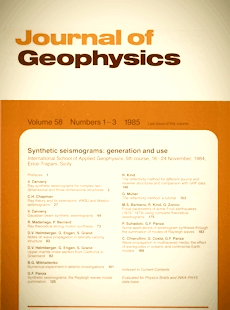Ray theory and its extensions: WKBJ and Maslov seismograms
Article Sidebar

Vols. 1-18 (1924-1944), ISSN 0044-2801
Main Article Content
Abstract
Asymptotic ray theory can be used to describe many seismic signals. Provided the wavefronts and amplitudes vary smoothly and the correct phase changes are included for caustics and reflection/transmission coefficients, it successfully describes direct and turning rays, on normal and reversed branches with multiple turning points, and partial and total reflections and transmissions. Nevertheless, many exceptions occur. Critical points, head waves, interference head waves, Airy caustics, Fresnel shadows, edge, point and interface diffractions and gradient coupling are examples discussed in this paper. Asymptotic ray theory can be simply extended to cover some of these problems. In this paper, the extension called the WKBJ or Maslov seismogram is discussed.
 ARK: https://n2t.net/ark:/88439/y086318
ARK: https://n2t.net/ark:/88439/y086318
Permalink: https://geophysicsjournal.com/article/147
Article Details
References
Burridge, R. (1963a) The reflexion of a pulse in a solid space. Proc. Roy. Soc. A276:367-400
Burridge, R. (1963b) The reflexion of a disturbance within an elastic sphere. Ph.D. thesis, University of Cambridge
Cagniard, L. (1939) Reflexion et refraction des ondes seismiques progressives. Gauthier-Villars, Paris
Cagniard, L. (1962) Reflexion and refraction of progressive seismic waves, trans. E.A. Flinn and C.H. Dix. McGraw-Hill Book Co., New York
Cerveny, V., Ravindra, R. (1971) Theory of seismic head waves. University of Toronto Press, Toronto
Cerveny, V., Molotkov, I.A., Psencik, I. (1977) Ray method in seismology. Charles University Press, Prague
Chapman, C.H. (1978) A new method for computing synthetic seismograms. Geophys. J. R. Astron. Soc. 54:481-518
Chapman, C.H. (1981) Long-period corrections to body-waves: theory. Geophys. J. R. Astron. Soc. 64:321-372
Chapman, C.H., Drummond, R. (1982) Body-wave seismograms in inhomogeneous media using Maslov asymptotic theory. Bull. Seismol. Soc. Amer. 72, S277-S317
Courant, R., Hilbert, D. (1962) Methods of mathematical physics. John Wiley and Sons, New York
Gebrande, H. (1976) A seismic-ray tracing method for two-dimensional inhomogeneous media. In: Giese, P., Prodehl, C., Stein, A. (Eds.) Exploration seismology in Central Europe: data and results, pp. 162-167. Springer, Berlin
Gilbert, F. (1960) Scattering of impulsive elastic waves by a smooth convex cylinder. J. Acous. Soc. Amer. 32:841-856
Gilbert, F., Backus, G.E. (1966) Propagator matrices in elastic wave and vibration problems. Geophysics 31:326-333
Heyman, E., Felsen, L.B. (1984) Non-dispersive approximations for transient ray fields in an inhomogeneous medium. In: Proceedings of the NATO Advanced Research Workshop on Hybrid Formulation of Wave Propagation and Scattering. Nijhoff Publishing Co.
Hill, D.P. (1973) Critical refracted waves in a spherically symmetric, radially heterogeneous Earth model. Geophys. J. R. Astron. Soc. 34:149-179
de Hoop, A.T. (1960) A modification of Cagniard's method for solving seimic pulse problems. Appl. Scient. Res. BS:349-356
Hormander, L. (1971) Fourier integral operators. Acta Math. 127:79-183
Hormander, L. (1979) Spectral analysis of singularities. In: Hormander, L. (Ed.) Seminar on singularities of solutions of linear partial differential equations, pp 3-49. Princeton Univ. Press
Hron, F., Kanasewich, E. R. (1971) Synthetic seismograms for deep seismic sounding studies using asymptotic ray theory. Bull. Seismol. Soc. Amer. 61:1169-1200
Jackson, P.S. (1971) The focusing of earthquakes. Bull. Seismol. Soc. Amer. 61:685-695
Keller, J.B. (1958) Corrected Bohr-Sommerfeld quantum conditions for non-separable systems. Ann. Phys. 4:180-188
Keller, J.B. (1962) The geometrical theory of diffraction. J. Opt. Soc. Amer. 52:116-130
Kennett, B.L.N., Illingworth, M.R. (1981) Seismic waves in a stratified half space - III. Piecewise smooth models. Geophys. J. R. Astron. Soc. 66:633-675
Kline, M., Kay, I.W. (1965) Electromagnetic theory and geometrical optics. John Wiley and Sons, New York
Knopoff, L., Gilbert, F. (1961) Diffraction of elastic waves by the core of the earth. Bull. Seismol. Soc. Amer. 51:35-49
Ludwig, D. (1966) Uniform asymptotic expansion at a caustic. Comm. Pure Appl. Math. 29:215-250
McMechan, G.A., Mooney, W.D. (1980) Asymptotic ray theory and synthetic seismograms for laterally varying structures: theory and application to the Imperial Valley, California. Bull. Seismol. Soc. Amer. 70:2021-2035
Madariaga, R. (1984) Gaussian beam synthetic seismograms in a vertically varying medium. Geophys. J. R. Astron. Soc. 79:589-612
Marks, L.W., Hron, F. (1977) Weber function computation in the interference reflected head wave amplitude. Geophys. Res. Lett. 4:255-258
Marks, L.W., Hron, F. (1980) Calculation of synthetic seismograms in laterally inhomogeneous media. Geophysics 45:509-510
Maslov, V.P. (1965) Theory of perturbations and asymptotic methods (in Russian). Izd. MGU, Moscow
Milnor, J. (1969) Morse theory. Princeton Univ. Press
Pekeris, C.L. (1955a) The seismic surface pulse. Proc. Nat. Acad. Sci. USA 41:469-480
Pekeris, C.L. (1955b) The seismic buried pulse. Proc. Nat. Acad. Sci. USA 41:629-639
Richards, P.G., Frasier, C.W. (1976) Scattering of elastic waves from depth-dependent inhomogeneities. Geophysics 41:441-458
Scholte, J.G.J. (1962) Oblique propagation of waves in inhomogeneous media. Geophys. J. R. Astron. Soc. 7:244-261
Smirnov, V.I. (1964) A course in higher mathematics, Vol. 4, trans. D.E. Brown and I.N. Sneddon. Pergammon Press, Oxford
Stickler, D.C., Ahluwalia, D.S., Ting, L. (1981) Application of Ludwig's uniform progressing wave ansatz to a smooth caustic. J. Acous. Soc. Amer. 69:1673-1681
Thomson, C.J., Chapman, C.H. (1985) An introduction to Maslov's asymptotic method. Geophys. J. R. Astron. Soc. (in press)
Whittal, K.P., Clowes, R.M. (1979) A simple, efficient method for the calculation of travel-times and ray paths in laterally inhomogeneous media. J. Can. Soc. Exp. Geophys. 15:21-29
Will, M. (1976) Calculation of travel-times and ray paths for lateral inhomogeneous media. In: Giese, P., Prodehl, C., Stein, A. (Eds.) Explosion seismology in Central Europe: dates and results, pp. 168-177. Springer-Verlag, Berlin
Ziolkowski, R.W., Deschamps, G.A. (1984) Asymptotic evaluation of high frequency fields near a caustic: an introduction to Maslov's method. Radio Science 19:1001-1025











